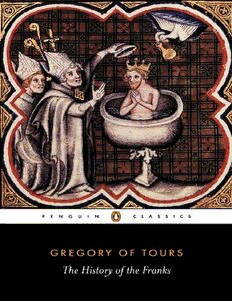
A History of the Franks by Gregory of Tours PDF
Preview A History of the Franks by Gregory of Tours
THE HISTORY OF THE FRANKS ADVISORY EDITOR: BETTY RADICE GREGORY OF TOURS was Metropolitan Bishop of that city from 573 until his death in 594. He was a Gallo-Roman who spoke and wrote sixth-century latin as his native language. On both his mother’s and his father’s side he came of distinguished senatorial families. During his episcopate the civil rule in Tours passed from Sigibert to Chilperic and then again to Childebert II, during whose minority Guntram exercised control. Gregory wrote many books. The most famous of them, The History of the Franks, begins with the Creation; but much of it is an eye-witness account of the bloodthirsty behaviour of these four Merovingian Kings and their savage consorts. Gregory was later canonized. LEWIS THORPE, BA, L-ès-L, PhD, D de l’U, LLD, FIAL, FRSA, FR HistS, was Professor of French at Nottingham University from 1958 to 1977. He joined the staff of that university in 1946 after distinguished war service. He was President of the British Branch of the International Arthurian Society, and editor of the Society’s Bulletin Bibliographique. He was also editor of Nottingham Mediaeval Studies and Nottingham French Studies. He published many articles, and his books include La France guerrière (1945), Le Roman de Laurin, fils de Marques le Sénéchal (1950), Le Roman de Laurin, text of MS. B.N.f.fr. 22548 (1960), Guido Farina, Painter of Verona, 1896–1957 (1967) with Barbara Reynolds, Einhard the Frank: The Life of Charlemagne (1970), Le Roman de silence, by Heldris de Cornuälle (1972) and The Bayeux Tapestry and the Norman Invasion (1973). He also translated Geoffrey of Monmouth: The History of the Kings of Britain, Two Lives of Charlemagne and Gerald of Wales: The Journey through Wales and The Description of Wales for the Penguin Classics. Lewis Thorpe was a member of the MCC. He died on 10 October 1977. GREGORY OF TOURS THE HISTORY OF THE FRANKS Translated with an Introduction by Lewis Thorpe PENGUIN BOOKS PENGUIN BOOKS Published by the Penguin Group Penguin Books Ltd, 80 Strand, London WC2R 0RL, England Penguin Putnam Inc., 375 Hudson Street, New York, New York 10014, USA Penguin Books Australia Ltd, 250 Camberwell Road, Camberwell, Victoria 3124, Australia Penguin Books Canada Ltd, 10 Alcorn Avenue, Toronto, Ontario, Canada M4V 3B2 Penguin Books India (P) Ltd, 11 Community Centre, Panchsheel Park, New Delhi – 110 017, India Penguin Books (NZ) Ltd, Cnr Rosedale and Airborne Roads, Albany, Auckland, New Zealand Penguin Books (South Africa) (Pty) Ltd, 24 Sturdee Avenue, Rosebank 2196, South Africa Penguin Books Ltd, Registered Offices: 80 Strand, London WC2R 0RL, England www.penguin.com This translation first published 1974 30 Copyright © the Estate of Lewis Thorpe, 1974 All rights reserved Except in the United States of America, this book is sold subject to the condition that it shall not, by way of trade or otherwise, be lent, re-sold, hired out, or otherwise circulated without the publisher’s prior consent in any form of binding or cover other than that in which it is published and without a similar condition including this condition being imposed on the subsequent purchaser EISBN: 9781101490754 CONTENTS INTRODUCTION I Gregory of Tours Genealogical table: the family of Gregory of Tours II The Times in which Gregory lived Genealogical table: the Merovingians, down to Dagobert III Gregory’s Writings IV The History of the Franks 1. Intention and shape 2. Historical and literary debts 3. Personal knowledge 4. Credibility 5. Other historians of the period 6. Language 7. Style 8. Humour and irony 9. Nature notes 10. The manuscripts 11. Earlier translations 12. This translation V Gregory down the Centuries VI Short Bibliography ABBREVIATIONS USED FOR THE BOOKS WRITTEN BY GREGORY OF TOURS MAP OF GAUL PREFACE BOOK I BOOK II BOOK III BOOK IV BOOK V BOOK VI BOOK VII BOOK VIII BOOK IX BOOK X INDEX INTRODUCTION I. GREGORY OF TOURS The historian who was to become known to the world as Gregory, 1 nineteenth Bishop of Tours, was born on 30 November c.539, in what is now Clermont-Ferrand, Puy-de-Dôme, and what was then Arvernus or Arvernorum civitas, the chief city of Arvernia or Auvergne. He was baptized Georgius Florentius. On both his father’s and his mother’s side he came of distinguished senatorial families with a long tradition of service to the Catholic Church, that is to say of wealthy Gallo-Roman landed gentry whose ancestors had enjoyed the rank of Senators under the Empire and were still extremely proud of the fact. His father was the Senator Florentius and his paternal grandfather was the Senator 2 3 Georgius, both of Clermont. His mother was Armentaria, grand- daughter of Saint Tetricus, Bishop of Langres, 539–72, and great-grand- daughter of Saint Gregory, also Bishop of Langres, 507–39. Gregory’s immediate predecessor as Bishop of Tours, Saint Eufronius, 556–73, was his first cousin once removed. Duke Gundulf and his brother Saint 4 Nicetius, Bishop of Lyons, 552–73, were two of Armentaria’s uncles. When Bishop Eufronius was introduced to King Lothar I as a descendant of Saint Gregory of Langres, the King replied: ‘That is one of the noblest 5 and most distinguished families in the land’. Gregory had many other famous forbears; and, indeed, he himself said that of the eighteen Bishops who preceded him in Tours all but five were his blood- 6 relations. There was even an early Christian martyr in the family, 7 Vettius Epagatus, who was killed in Lyons in 177.
